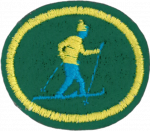Especialidades JA/Esquí de fondo
| Esquí de fondo | ||
|---|---|---|
| Asociación General
|
Destreza: 2 Año de introducción: 1986 |
|
Requisitos
|
La especialidad de Esquí de fondo es un componente de la Maestría Recreación. |
1
1a
1b
New Nordic Norm
Rottefella developed the New Nordic Norm (NNN) binding, and licenses it to Rossignol, Madshus, Atomic, and, beginning in 2007, Fischer. These bindings have subtypes, such as the NNN-BC for backcountry use, the R3 Skate, the R3 Classic, and the R4 NIS (Nordic Integrated System). The NIS system requires skis that have a permanently bonded plate that the binding slides onto. This allows for the skier to mount their own bindings without needing to screw into the ski. By doing this the skier can easily tune the position of the binding relative to the center of gravity of the ski, said to be useful in different snow conditions. NNN boots are made by Alpina Sports, Madshus, Rossignol and beginning in 2007, Fischer. The R3 and R4 are generally the choice for World Cup Racers using NNN. These are distinguished from the SNS (Salomon and Atomic) binding in that all NNN bindings have two longitudinal ridges that stick out from the bottom of the binding that mate with corresponding slots in NNN boots. There is much debate over which is the superior binding system: SNS or NNN. Overall, the differences between the NNN and SNS binding systems are minuscule to the average skier; the choice should come down to which binding fits with the boot that happens to fit a given skier.
The R4 NIS binding, made by Rottefella and Rossignol, is the newest variant of the NNN binding. These bindings are compatible with any NNN boot, but can only be used on skis that come with the permanently bonded plate, presently made only by Rossignol, Madshus, and Fischer. The NIS binding made its debut to the general public in 2005.
Salomon Nordic System Profil
Salomon Nordic System (SNS) bindings, made by Salomon and Atomic, however, have their advantages too. Boots that are compatible with the SNS Profil system are made by Salomon, Atomic, Adidas, and Hartjes. SNS Profil bindings are used for both Skating and Classic. As opposed to the SNS Pilot's two axes, these boots have only one axis at the front of the sole. Pilots are used by many different racers on the World Cup Circuit. Profil bindings are the standard binding for SNS users, its only competition being the SNS Pilot system. Profil comes in "Equipe" models for racing, "Active" for recreational racing/combination, Auto Touring, and Back Country. Fischer was for many years synonymous with SNS as well, but switched to the more widely used NNN for the 2007/2008 season and beyond.
Salomon Nordic System Pilot
SNS Pilot bindings, compatible with Salomon, Atomic, Adidas and Hartjes boots. As of the 2006/2007 season, Atomic will also have SNS pilot on their boots. The idea for these bindings came from Bjørn Dæhlie. Pilots are used mostly by elite skiers at the Collegiate/Olympians/World Cup/National level, although it is common to find High School/Citizen Racers with these bindings and their counterpart boots. Pilots are more expensive than Profils at about 100 U.S. dollars for a pair, and have two completely different designs for skate skiing and classical skiing. In Pilot boots, two axes (metal bars), one positioned about 1" (2.5 cm) behind the other, click into two different slots in the Pilot binding. Profil boots only have one axis and therefore cannot fit into Pilot bindings. However, Pilot boots can fit into most Profil bindings, due to a small space behind the front of the boot for the other axis. Pilot Skate bindings are superior to Profil due to the two latches reducing ski motion in the air. The Pilot Classic (released at the end of the 2005-2006 season) doesn't have the bumper found on all NNN and SNS Profil bindings. These new boots and bindings provide a superior subtle kick through a spring loaded back slot for the back axis. Unlike the rubber bumpers, this spring has adjustable tension that can be changed in different snow conditions. Fischer has now started producing their new boots with the NNN system.
1c
1d
2
2a
2b
2c
2d
3
4
4a
4b
4c
4d
4e
4f
4g
4h
4i
4j
5
6
7
8
8a
8b
8c
Referencias
- Categoría: Tiene imagen de insignia
- Adventist Youth Honors Answer Book/Honors/es
- Adventist Youth Honors Answer Book/es
- Adventist Youth Honors Answer Book/Skill Level 2/es
- Categoría: Libro de respuestas de especialidades JA/Especialidades introducidas en 1986
- Adventist Youth Honors Answer Book/General Conference/es
- Adventist Youth Honors Answer Book/Recreation/es
- Adventist Youth Honors Answer Book/Recreation/Primary/es
- Adventist Youth Honors Answer Book/Stage 0/es
- Adventist Youth Honors Answer Book/Recreation Master Award/es
- Adventist Youth Honors Answer Book


